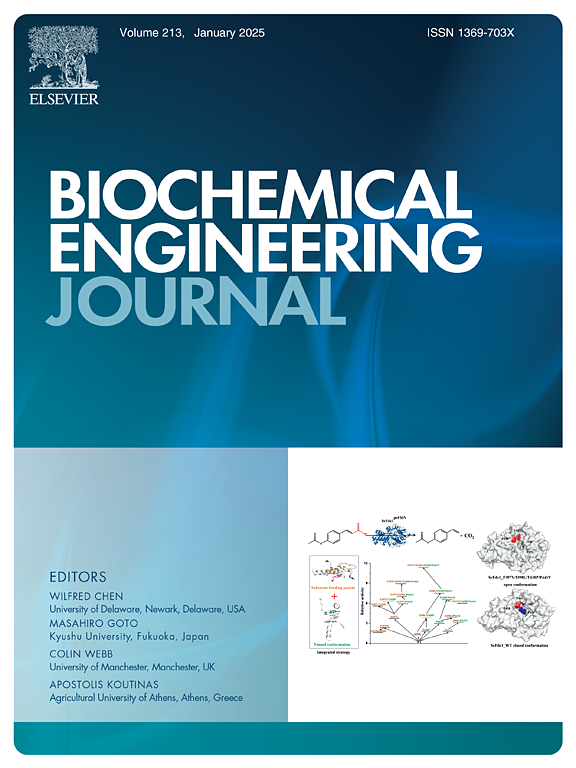Enhanced nitrogen removal at low temperature using low frequency-low voltage alternating electric current
IF 3.7
3区 生物学
Q2 BIOTECHNOLOGY & APPLIED MICROBIOLOGY
引用次数: 0
Abstract
Wastewater with a low COD/TIN ratio has low organic content and is difficult to treat at low-temperature conditions. To strengthen nitrogen removal performance at low temperature, this study adopted an up flow anaerobic-aerobic coupling system and applied low-frequency and low-voltage sinusoidal alternating current (LFV-AC) in an intermittent power supply mode. 5 Hz LFV-AC stimulation removed 80.6 % NH4+-N, which was 24.4 % greater than that of the control group. Using 10 Hz, 38.6 % more total inorganic nitrogen was removed than that in the control group. The results of the study show that intermittent LFV-AC stimulation can effectively increase the activity of denitrogenation-related enzyme genes and enhance their adaptability to low-temperature environments in biofilm reactors. Electrostimulation selectively enriched denitrifying bacteria (Thiothrix, Reyranella, Hydrogenophaga, Pseudomonas, etc.) and heterotrophic nitrifying and aerobic denitrifying bacteria Delftia associated with denitrification. However, LFV-AC with varying parameters exhibited distinct effects on the enrichment of denitrifying functional genes, resulting in differential accumulation of NO3--N concentrations. This further confirms the effectiveness of intermittent LFV-AC electrical stimulation in the treatment of low COD/TIN wastewater in biofilm reactors and provides an important reference for LFV-AC treatment of nitrogen-containing wastewater.
利用低频低压交流电加强低温脱氮
COD/TIN比低的废水有机含量低,在低温条件下难以处理。为加强低温下的脱氮性能,本研究采用上流式厌氧-好氧耦合系统,采用低频低压正弦波交流电(LFV-AC)间歇供电方式。5 Hz LFV-AC刺激去除80.6 % NH4+-N,比对照组高出24.4 %。使用10 Hz时,总无机氮去除率比对照组高38.6 %。研究结果表明,间歇LFV-AC刺激可有效提高生物膜反应器中脱氮相关酶基因的活性,增强其对低温环境的适应性。电刺激选择性富集反硝化细菌(thiiothrix、Reyranella、Hydrogenophaga、Pseudomonas等)和与反硝化相关的异养硝化和好氧反硝化细菌Delftia。然而,不同参数的LFV-AC对反硝化功能基因富集的影响不同,导致NO3——N浓度积累的差异。这进一步证实了间歇LFV-AC电刺激处理生物膜反应器低COD/TIN废水的有效性,为LFV-AC处理含氮废水提供了重要参考。
本文章由计算机程序翻译,如有差异,请以英文原文为准。
求助全文
约1分钟内获得全文
求助全文
来源期刊

Biochemical Engineering Journal
工程技术-工程:化工
CiteScore
7.10
自引率
5.10%
发文量
380
审稿时长
34 days
期刊介绍:
The Biochemical Engineering Journal aims to promote progress in the crucial chemical engineering aspects of the development of biological processes associated with everything from raw materials preparation to product recovery relevant to industries as diverse as medical/healthcare, industrial biotechnology, and environmental biotechnology.
The Journal welcomes full length original research papers, short communications, and review papers* in the following research fields:
Biocatalysis (enzyme or microbial) and biotransformations, including immobilized biocatalyst preparation and kinetics
Biosensors and Biodevices including biofabrication and novel fuel cell development
Bioseparations including scale-up and protein refolding/renaturation
Environmental Bioengineering including bioconversion, bioremediation, and microbial fuel cells
Bioreactor Systems including characterization, optimization and scale-up
Bioresources and Biorefinery Engineering including biomass conversion, biofuels, bioenergy, and optimization
Industrial Biotechnology including specialty chemicals, platform chemicals and neutraceuticals
Biomaterials and Tissue Engineering including bioartificial organs, cell encapsulation, and controlled release
Cell Culture Engineering (plant, animal or insect cells) including viral vectors, monoclonal antibodies, recombinant proteins, vaccines, and secondary metabolites
Cell Therapies and Stem Cells including pluripotent, mesenchymal and hematopoietic stem cells; immunotherapies; tissue-specific differentiation; and cryopreservation
Metabolic Engineering, Systems and Synthetic Biology including OMICS, bioinformatics, in silico biology, and metabolic flux analysis
Protein Engineering including enzyme engineering and directed evolution.
 求助内容:
求助内容: 应助结果提醒方式:
应助结果提醒方式:


